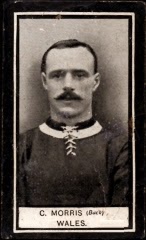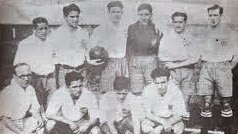R. Templeton (Woolwich Arsenal)
Bobby Templeton was an outside right. He began and ended his career with Kilmarnock, also playing for Aston Villa, Newcastle United, Woolwich Arsenal, Celtic and Fulham.
He represented Scotland 11 times. In 1908 he entered a lion's cage and twisted the animal's tail for a wager.
T.A. Soar (Fulham)
Albert Soar was a light and nippy 'A skilful ball-player whose every touch spoke eloquently of his ability', Other senior clubs represented were Nottingham Forest, Derby County and Watford. He suffered a career ending injury at Watford aged 27.
Lipsham (Sheffield United)
Bert Lipsham played for Chester City, Crewe Alexandra , Sheffield United and Fulham. It was whilst with the Blades that he enjoyed his best days, winning the FA Cup and getting his single England cap in 1902. After his playing days were over he managed Millwall.
Hampton (Aston Villa)
In 16 years at Villa Happy Harry scored 242 goals in 376 games. He won the FA Cup in 1905 (scoring both goals in the final) and was capped 4 times by England.
Vivian Woodward (Tottenham Hotspur)
The amateur Vivian Woodward was a goal machine in international football and a double Olympic gold medalist.
Jack Sharp (Everton)
Sharp was a double international (football and cricket) and an FA Cup winner (1906).
F. Blackburn (West Ham United)
Fred Blackburn joined West Ham from Blackburn Rovers (his hometown club). He represented England 3 times.
J. Long (Reading)
Jimmy Long was a Scotsman- his career began at Clyde and he played League Football for Grimsby Town and Derby County, punctuated by 2 years with Reading in the Southern League.
Appleyard (Newcastle United)
Bill Appleyard has 109 first class goals to his name, 87 of them with Newcastle United.








.jpg)
.jpg)







.jpg)











.jpg)


.jpg)




.jpg)
















